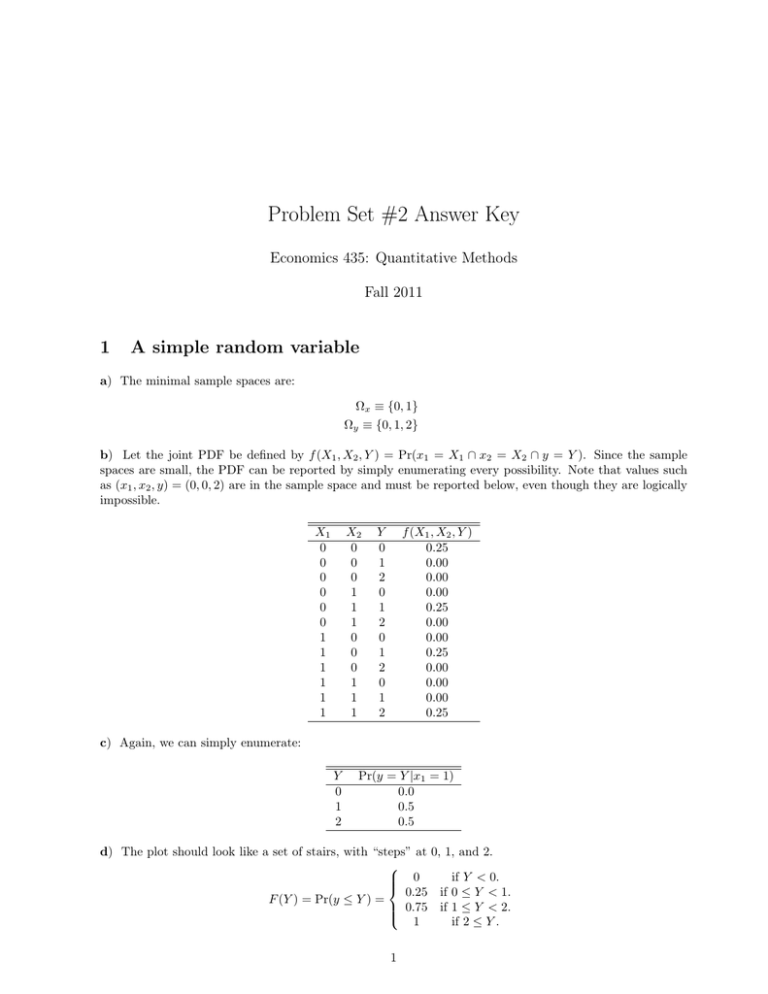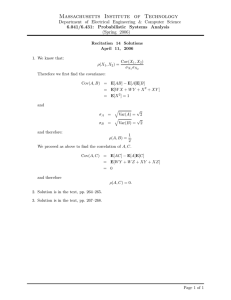Problem Set #2 Answer Key 1 A simple random variable
advertisement

Problem Set #2 Answer Key
Economics 435: Quantitative Methods
Fall 2011
1
A simple random variable
a) The minimal sample spaces are:
Ωx ≡ {0, 1}
Ωy ≡ {0, 1, 2}
b) Let the joint PDF be defined by f (X1 , X2 , Y ) = Pr(x1 = X1 ∩ x2 = X2 ∩ y = Y ). Since the sample
spaces are small, the PDF can be reported by simply enumerating every possibility. Note that values such
as (x1 , x2 , y) = (0, 0, 2) are in the sample space and must be reported below, even though they are logically
impossible.
X1
0
0
0
0
0
0
1
1
1
1
1
1
X2
0
0
0
1
1
1
0
0
0
1
1
1
Y
0
1
2
0
1
2
0
1
2
0
1
2
f (X1 , X2 , Y )
0.25
0.00
0.00
0.00
0.25
0.00
0.00
0.25
0.00
0.00
0.00
0.25
c) Again, we can simply enumerate:
Y
0
1
2
Pr(y = Y |x1 = 1)
0.0
0.5
0.5
d) The plot should look like a set of stairs, with “steps” at 0, 1, and 2.
0
if Y < 0.
0.25 if 0 ≤ Y < 1.
F (Y ) = Pr(y ≤ Y ) =
0.75 if 1 ≤ Y < 2.
1
if 2 ≤ Y .
1
ECON 435, Fall 2011
2
e) There are a lot of ways to figure this one out. You could calculate it directly from the probabilities, but
the easiest way is to use some of our results about expected values.
E(y|x1 ) = E(x1 + x2 |x1 ) = x1 + E(x2 |x1 ) = x1 + E(x2 ) = x1 + 0.5
f) This one is trickier. You need to manipulate the joint and conditional probabilities directly.
E(x1 |y)
=
0 ∗ Pr(x1 = 0|y) + 1 ∗ Pr(x1 = 1|y)
=
Pr(x1 = 1|y)
Pr(x1 = 1 ∩ y = 0)
Pr(x1 = 1 ∩ y = 1)
Pr(x1 = 1 ∩ y = 2)
I(y = 0) +
I(y = 1) +
I(y = 2)
Pr(y = 0)
Pr(y = 1)
Pr(y = 2)
0
0.25
0.25
I(y = 0) +
I(y = 1) +
I(y = 2)
0.25
0.5
0.25
0.5y
=
=
=
g) This problem can be solved by brute force, but it is easier if you notice that:
var(y)
= var(x1 ) + var(x2 ) + 2cov(x1 , x2 )
= var(x1 ) + var(x2 )
=
cov(x1 , y)
2var(x1 )
since x1 and x2 are independent
since x1 and x2 are identically distributed
= cov(x1 , x1 + x2 )
by substitution
= cov(x1 , x1 ) + cov(x1 , x2 )
= cov(x1 , x1 )
by linearity of expectations
since x1 and x2 are independent
= var(x1 )
Therefore:
corr(x1 , y)
2
cov(x1 , y)
=
p
=
var(x1 )var(y)
var(x1 )
p
2 ∗ var(x1 )var(x1 )
=
1
√ ≈ 0.71
2
The effects of smoking
a) The probability is just
20,000
30,000,000
= 0.0666666%.
b) We apply Bayes’ law to get:
Pr(diagnosed|smoker)
Pr(smoker|diagnosed) Pr(diagnosed)
Pr(smoker)
0.75 ∗ 0.0006666666
=
0.2
= 0.25%
=
ECON 435, Fall 2011
3
c) We apply Bayes’ law to get:
Pr(nonsmoker|diagnosed) Pr(diagnosed)
Pr(nonsmoker)
0.25 ∗ 0.00666666
=
0.8
= 0.021%
Pr(diagnosed|nonsmoker)
=
d) A smoker is twelve times as likely as a nonsmoker to get lung cancer in a given year.
3
Probability theory
a) First we note that A2 can be partitioned into the pair of disjoint subsets A2 ∩ A1 and A2 ∩ Ac1 . By the
definition of a probability distibution:
Pr(A2 ) = Pr(A2 ∩ A1 ) + Pr(A2 ∩ Ac1 )
Now, since A1 ⊂ A2 , we have A2 ∩ A1 = A1 . Substituting in to the equation above, we have:
Pr(A2 ) = Pr(A1 ) + Pr(A2 ∩ Ac1 )
Since all probabilities are nonnegative, the result follows.
b) First, the definition of conditional expectation implies that:
Pr(A3 |A1 ∪ A2 )
=
=
Pr(A3 ∩ (A1 ∪ A2 ))
Pr(A1 ∪ A2 )
Pr((A3 ∩ A1 ) ∪ (A3 ∩ A2 ))
Pr(A1 ∪ A2 )
Since A1 and A2 are disjoint, these probabilities can be separated:
Pr((A3 ∩ A1 ) ∪ (A3 ∩ A2 ))
Pr(A1 ∪ A2 )
Pr(A3 ∩ A1 ) + Pr(A3 ∩ A2 ))
Pr(A1 ) + Pr(A2 )
Pr(A3 |A1 ) Pr(A1 ) + Pr(A3 |A2 ) Pr(A2 )
Pr(A1 ) + Pr(A2 )
=
=
c) We have:
Pr(A1 |A2 )
=
=
4
Pr(A1 ∩ A2 )
Pr(A2 )
Pr(A2 |A1 ) Pr(A1 )
Pr(A2 )
Properties of expectations
a) By definition we have:
var(X)
h
i
2
= E (X − E(X))
= E X 2 − 2XE(X)E(X)2
= E(X 2 ) − E(X)2
ECON 435, Fall 2011
4
b) We have:
cov(aX + bY, cX + dY )
= E [((aX + bY ) − E(aX + bY )) ((cX + dY ) − E(cX + dY ))]
= E [(a(X − E(X)) + b(Y − E(Y ))) (c(X − E(X)) + d(Y − E(Y )))]
= ac var(X) + bd var(Y ) + (ad + bc) cov(X, Y )
c) First, we note that
E(g(X)Y |X) = g(X)E(Y |X) = g(X) ∗ 0 = 0
Taking expectations of both sides, and applying the law of iterated expectations we have:
E(g(X)Y ) = E(E(g(X)Y |X)) = E(0)
5
Basic data manipulation in R
This code will work:
rbern <- function(n,k,p) {
x1 <- runif(n*k)
x2 <- as.integer(x1 < p)
matrix(x,nrow=n)
}
x <- bern(3,5,0.75)
print(x)
apply(x,2,mean)
It wouldn’t be following the instructions, but the rbern function could be written more briefly as:
rbern <- function(n,k,p) matrix(as.integer(runif(n*k)<p),nrow=n)









